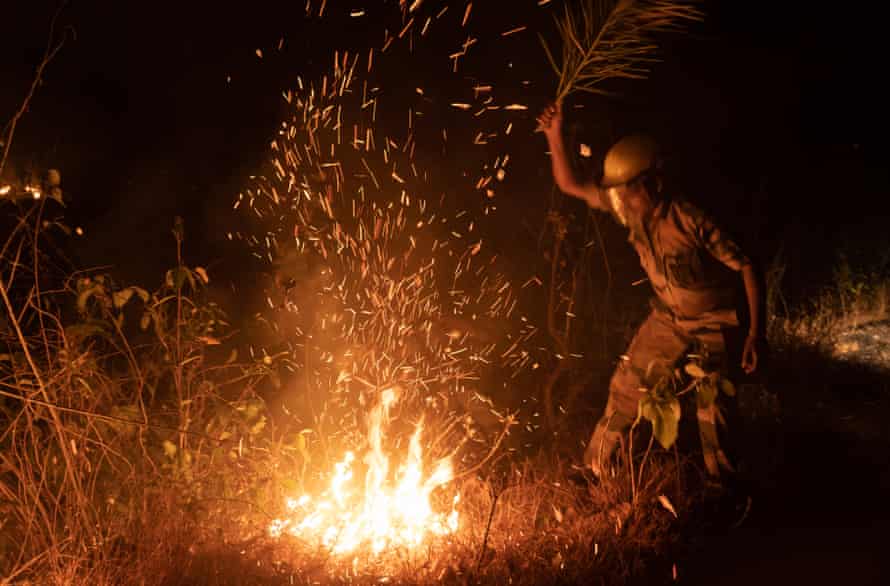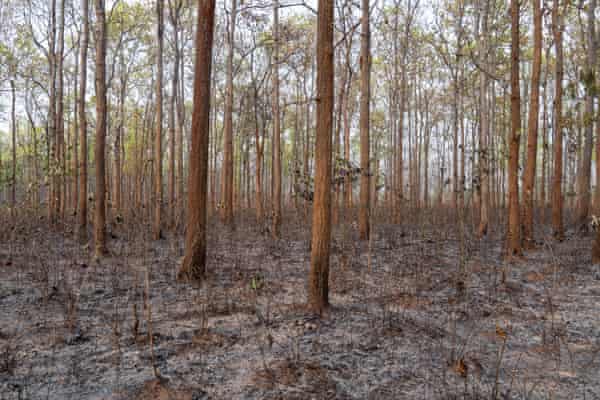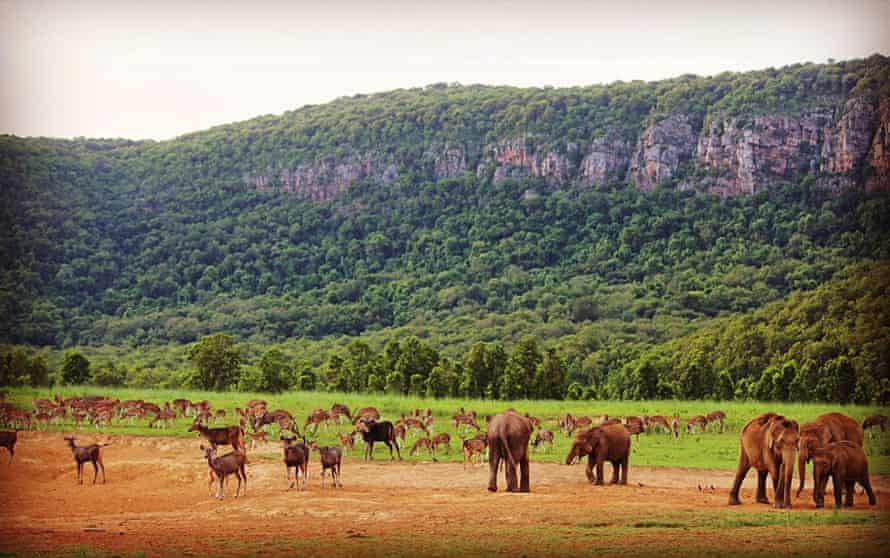As the flames move fast, snaking quickly upwards in the treacherous terrain of Similipal national park and turning everything on the ground to smoky ash, the women are in hot pursuit. Throwing their dupattas over their shoulders, sweat dripping from their foreheads, they vigorously whack the flames with leafy branches to extinguish them. Nearby, a forest department official armed only with a leaf blower works to move the leaves fuelling the fire out of the way.
Finally, as the hills of Similipal, in the Indian state of Odisha, become too steep, the women fall back. “It’s very smoky and hot, but for the past two weeks, we have been helping put out the fires in any way we can,” says Sanjukta Basa, chair of local environmental NGO Sangram.

For more than a month, Similipal national park and tiger reserve has been burning, causing untold devastation to Asia’s second-largest biosphere reserve. Living in this fragile ecosystem are tigers, leopards, elephants, deer, wild boar, pangolins, antelopes, more than 200 species of birds and about 3,000 species of plants, including rare orchids and many that are used medicinally by the indigenous communities in the area, known as the Adivasis, who live in 1,200 villages in and around the reserve.
Basa heads up a group of 10 women who work to protect Similipal. In recent weeks they have become de facto firefighters as they have attempted to get the fires under control. But fighting forest fires here is no easy feat. The virtually impenetrable protected forests of Similipal stretch over 2,150 sq miles (5,570 sq km) and cover steep, treacherous terrain, meaning they are largely inaccessible, except on foot.
No fire engine can reach these parts, so officials from the state forest department and volunteers use what resources they have to hand – leaf blowers and branches. “It’s hard, sometimes the flames have been eight to 10ft high, so we had no hope,” says Basa.
These forest fires are caused by humans. They are started by poachers and a minority of the local indigenous tribes, who use flames for hunting and foraging purposes. This year’s fires have been the worst in Similipal’s history owing to a collision of circumstances many believe could have been avoided.

Vanoo Mitra Acharya, wildife activist and co-founder of Sangram, says in his 20 years working in Similipal he has “never seen fires like this”. He says the region’s changing climate, along with the widening communication gap and rampant mistrust between the government forest department and tribal communities, is to blame.
“We have not had rain for about five months, which is very unusual, so the leaves on the ground have been burning like paper,” says Acharya. “But also, the forest department have lost the trust of the tribal communities, who are usually the first to put out these fires. Unlike in previous years, these villages did not call to give warnings and they did not fight the fires.”
He adds: “This failure of communication and failure of the government to act properly and quickly when the fires first broke out is the reason Similipal is still burning.”

Since 11 February, more than 3,400 fires have been detected across all four divisions of the national park, including about 350 within the tiger reserve. While most have been extinguished, some continue to burn. The Odisha forest department was accused of being ill-prepared, and the National Tiger Conservation Authority issued warnings to tiger reserves across India to be alert and take preventive measures against similar fires.
Some have accused the Odisha state government of showing little interest in fighting the fires until a Save Similipal social media campaign began to gain momentum at the beginning of March. The government has stated that no large trees or tiger, elephant or human lives have been lost. However, environmentalists say the fires will set Similipal back decades and local NGO Antyodaya Chetana Mandal estimates the fires have affected nearly 25% of the flora and fauna of the national park.
“The forest department is saying no severe damage has been done, which is ridiculous,” says Biswajit Mohanty, secretary of the Wildlife Society of Odisha.
“There has been a huge impact on the biodiversity of Similipal. Birds, snakes, lizards, monitor lizards, peacocks and pangolins would all have been caught up in the fire, but you won’t see that because they would have been reduced to ashes. Thousands of medicinal plants and saplings which are essential to the forest ecosystem have all been wiped out.”
“Similipal is famous for its orchids – it has 95 species – and thousands will have been lost.”

Much of the blame for the fires has been directed towards the Adivasi communities, who make up almost 75% of the occupants of the villages in Similipal. Yet while some Adivasis are involved in poaching and the practice of using fire to help forage for the mahua flower, which is used to make a liquor, most say it is only a small minority.
“Our village has always protected the forests,” says Tikaram Soren, the leader of a small village overlooking the forest. “We have faced tremendous resistance from other villages because we have been preventing all illegal activity such as logging, poaching, burning, even leaf picking, from the forests. We are worried because we have never seen it burn like this.”
Rabindra Mohanta, leader of local environmental protection group Vana Suraksha Samiti, who has been at the forefront of fighting the Similipal fires, says that with only a few forest department officers posted to cover thousands of square miles, the only way to stop the fires is to empower the local Adivasis.

“A few forest department people cannot do much, only the Adivasi community who live around here can save the jungle from the fires,” says Mohanta. “These people love the jungle – nature is still the God they worship from life to death.
“The forest department needs to listen to them, work hand in hand with them, and give them the financial compensation promised for helping to fight the fires.”
It is, nonetheless, a sisyphean task for the forest department officers responsible for vast areas of Similipal, with limited resources and personnel. Among them is Snehalata Dhal, 33, who has been a forest department officer for a decade. She says she has been spending every day and night trying to fight the fires in her 8 sq mile (20 sq km) area with nothing but branches. A video of her crying with joy as rains finally fell over Similipal last week went viral.

Dhal says: “I am trying my best to work with the local villages but more education is needed to stop them from setting these fires. More importantly, however, alternative livelihoods also need to be created for these people. They can’t keep depending so much on the forest because that is the route of the fires.”
Sangram is one of the few groups working to bridge the gap between the state and the Adivasis in an effort to save Similipal. Their methods are unusual, deploying a traditional street theatre group to perform to the Adivasis, spreading the message of how to save the jungle that is their home and their religion. Last week, as the forest fire smoke still hung heavy in the air, the troupe arrived in Palasbani village, neighbouring Similipal, where their songs gradually drew people from their houses.
“Let’s save the jungle that gives us life and the trees that give us oxygen,” they sang. “No more fires in Similipal.”
Find more age of extinction coverage here, and follow biodiversity reporters Phoebe Weston and Patrick Greenfield on Twitter for all the latest news and features